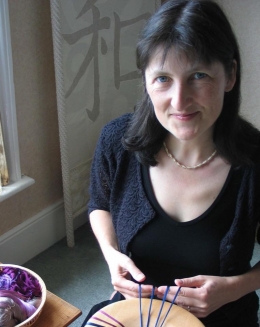Jacqueline Carey
INTERLACED: THE DIAGNOSIS, DOCUMENTATION AND DISCUSSION OF BRAID STRUCTURE
(Working title of MPhil/PhD)
Braids are a subgroup of textiles that date back to antiquity and can still be found throughout the world. They cover a broad spectrum of structures, from the ubiquitous 3-element ‘pigtail’ to complex 3-dimensional constructions. They are created using a range of production methods. Despite their commonplace nature, braids are not widely understood, and are frequently misinterpreted. Correct diagnostic analysis of a braid’s structure requires knowledge of ‘interworked’ structures, the idiosyncrasies of textile techniques and the nature of materials. An understanding of the historical and cultural context of the object can also assist in the identification of the structure.
Braidmaking tends to be a marginal technique within the field of textiles, so it is not surprising that research in this area has been limited in scale and scope. Over the past few decades there has been a growing interest in the subject within the practical craft domain. This has led to a wider awareness of the subject, and to the establishment of the Braid Society in 1993, an international group based in the UK. In keeping with the expansion of textile research, references to braids are appearing more frequently in academic texts, but mis-diagnosis and inconsistent terminology means that some of this work does not expand knowledge or understanding.
Many problems appear to stem from the difficulties surrounding the identification and discussion of braid structure. Although attempts have been made to find a common, systematic language for braids, notably through the work of Noémi Speiser, their structures often remain illusive. Current developments in research tend to focus on braid technique rather than on braid structure. Although the tendency to use technique to describe structure is widespread, it is not necessarily an ideal means of communication as it immediately imposes a bias when applied to extant objects.
The main aim of the proposed PhD research is to find an effective means of diagnosing, discussing and documenting braid structure, and thereby to create a body of information about braids, and so enhance understanding of the nature of braid structure - not just existing types, but also the wealth of unexplored possibilities. The two main outcomes expected of the research are diagnostic tools for the analysis of old braids, and characterisation information that will allow for the purposeful (i.e. function-specific) design of new braid structures.

